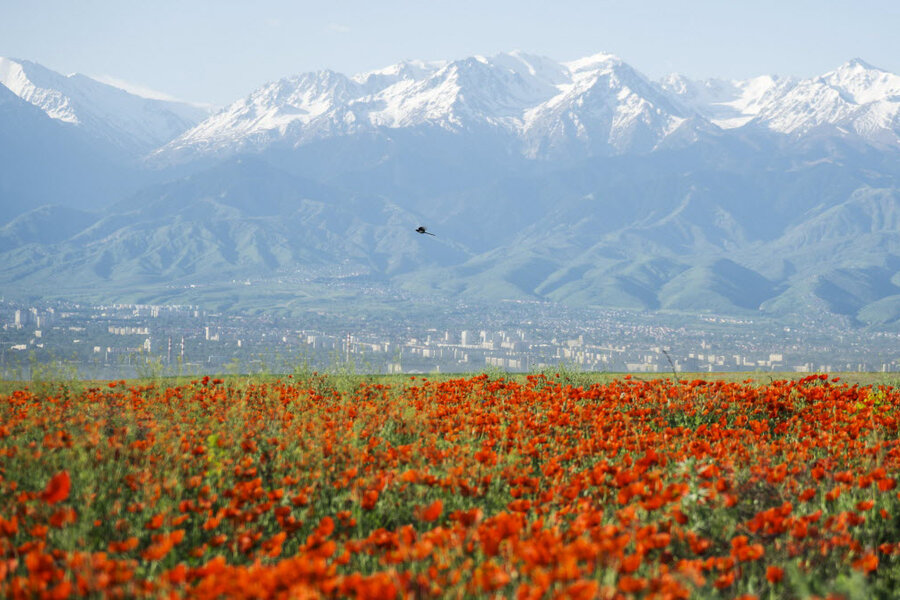Mountains hold climate change surprise, scientists find
Loading...
Global warming is expected to leave many plants and animals living on the world's mountains with nowhere to go but up – increasing their risk of extinction as they chase climatological comfort zones through landscapes that relentlessly shrink as they approach a summit.
At least that's the concept that has held sway for the past 30 years. But this simple picture is wrong for many of the world's major mountain ranges, a new study finds.
Instead, in many cases these migrants may wind up reaching altitudes where the landscape is relatively flat and extensive, giving them more room to spread out than they had at their original locations and perhaps enhancing their chances of surviving.
Until now, many ecologists had held that "species that shift up are always going to be losers," says Morgan Tingley, an ecologist at the University of Connecticut in Storrs. "It turns out that some of those species – depending on where they are – may actually win out for a bit."
The insight comes from five years of field work in the Himalayas and a close analysis of topographic maps for some 182 mountain ranges, explains Paul Elsen, a PhD student at Princeton University in New Jersey and the lead author of the study, published today in the journal Nature Climate Change.
New maps he and Dr. Tingley have generated could help refine efforts to conserve mountain species in the face of climate change, the two suggest.
The researchers note that, by itself, more living space is insufficient to improve the survival prospects for these migrants. But they argue that shrinking space can be just as detrimental to a species' survival prospects as a lack of suitable habitat in its new surroundings.
The study, which focuses on species that live below the timberline down to an elevation of about 1,000 feet, stems from field work Mr. Elsen had been conducting in the western Himalayas documenting the variety and distribution of bird species.
Mountain ranges "present a huge conservation challenge," he explains. Mountains host some of the most intricate biodiversity on Earth. Many species are unique to specific locations. Like their lowland counterparts, they also face increasing pressure from global warming and from land-use patterns such as farming or logging.
"We see this incredible diversity of birds at higher elevations, and I was wondering: What's going to happen if these species are going to shift farther upslope?" he recalls. He noticed that the higher he and his field team hiked, the closer they got to an expanse of land that extended ahead of them like a tabletop.
"Other hikers and biologists have noticed plateaus in mountain ranges, be we really didn't truly appreciate how common these might be and what they could mean for species shifting their ranges," he says.
For instance, Tingley cites the Himalayan monal, a rooster-size pheasant purported to have inspired the shape and color of the character Kevin in the 2009 animated film "Up." The Himalayan monal lives on very steep slopes at altitudes of around 8,000 feet.
"Because of the shape of the area of the mountains it lives in, it will actually have more area available to it as it shifts up" than it does now, Tingley says.
Based on what Elsen saw in the Himalayas, the two began to explore topographical patterns across mountain ranges around the world to see what opportunities or roadblocks they might present to species changing their ranges because of climate change.
Based on the maps he and Tingley analyzed, mountain-range profiles fell into four basic shapes, based in essence on the acreage available at different elevation ranges.
Only about 32 percent of the mountain ranges fell into the canonical, if rough-hewn, pyramid category, typified by the the Alps. The two researchers classified the rest as either diamond (the Rockies, 39 percent), hourglass (the Himalayas, 23 percent), or inverse pyramid (China's Kunlun Mountains, 6 percent), depending on changing patterns of plateaus and slopes with altitude.
To get some sense for the impact these various ranges could have on species' upward migration, the pair modeled an increase or decrease in the range of a hypothetical vertebrate species for each type of mountain range and at different altitudes. They assumed a 2-degree Celsius (3.6-degree Fahrenheit) increase above preindustrial levels for global average temperatures.
Among the findings: Areas with particularly steep slopes between more habitable patches in a mountain range may require intense conservation focus. As difficult as these bottlenecks might be for many species to traverse, they represent the only routes from one favorable part of the mountain range to another.
Mountains historically have been refuges for highly diverse wildlife and acted as hotbeds of evolutionary change, in no small part because they rise through a range of climate conditions, Tingley notes.
But that refuge also would include lowland species that climate change would force into the mountains, notes Christy McCain, an ecologist at the University of Colorado at Boulder and a curator of vertebrates at the university's Museum of Natural History. These species would be particularly vulnerable, even at low elevations, because any move upslope would automatically present a smaller range than the species were used to in their lowland habitats. The definition of mountains Elsen and Tingley used excludes this group.
Once this source of migration is taken into account, roughly 75 percent of the mountain ranges would resemble the canonical pyramid, she says.
"A lot of the mediation plans are talking about where low-elevation species move," she notes.
Still, for conserving species endemic to mountainsides, the study could be quite useful, she adds.
"If you're Rocky Mountain National Park, ... for planning purposes this perspective might be really helpful."








